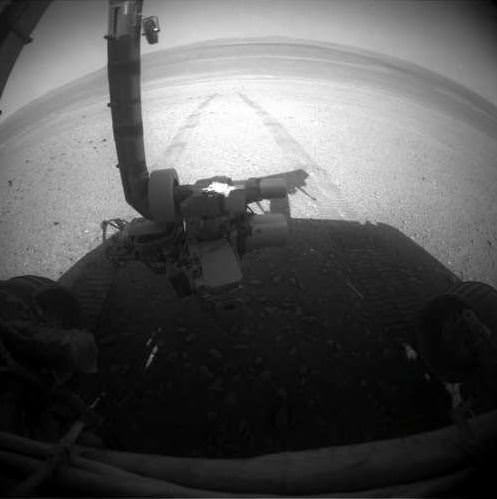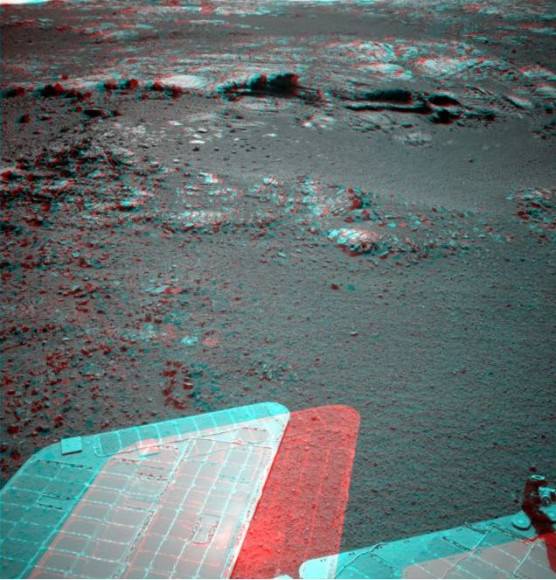The Opportunity Mars rover looks back at the tracks left along the rim of Endeavour Crater. Credit: NASA/JPL-Caltech
Meanwhile, back in Meridiani Planum … the Opportunity rover keeps on trucking, and has now exceeded over 35 kilometers (21.75 miles) of driving on its odometer! Quite an accomplishment for the Energizer Bunny of Mars rovers, now operating for 3,057 Martian sols. As the MER team says, “Not bad for a vehicle designed for only about 1 kilometer (.6 miles) of distance and 90 sols (days) of lifetime.”
Oppy is now moving south along the inboard edge of Cape York on the rim of Endeavour Crater surveying exposed outcrop in search of phyllosilicate clay minerals that have been detected from orbit. These outcrops are quite interesting and attention-grabbing; here’s a look in color from Stuart Atkinson:

and in 3-D:
Wow!
As Stu writes in his Road to Endeavour blog, “What are those rocks made of? How did this feature form? What do the diferent colours and textures mean? These are all questions which the MER team will be hoping to answer over the next few days, I’m sure. I think we’ll see Oppy driving closer to this outcrop and studying it in a lot of detail.”
The MER team reports that on Sol 3055 (Aug. 27, 2012), the Rock Abrasion Tool (RAT) on the end of the robotic arm was imaged (top image) to re-confirm the available bit for future grinding and the Alpha Particle X-ray Spectrometer (APXS) collected a measurement of atmospheric argon.
Opportunity’s solar array energy production is good, producing about 568 watt-hours.
So, even though the Curiosity rover is grabbing the headlines, don’t forget that Opportunity is still keepin’ on, working hard on Mars.
Sources: NASA/JPL, Road to Endeavour



Who will get to and analyze phyllosilicates first, Opportunity or Curiosity?
The race is ON!
I’m hoping Oppy does! Age over Shiny!!
MER cost was US$820 million, plus US$20 million per extention (5). Curiosity cost is US$2.5 billion. In comparison, the cost for the original WTC towers was US$900 million, which is about US$5 billion in today’s dollars.
I’ve said it before but I just have to again.
I don’t see why we don’t whip up a half dozen more of those rovers & send them to the most interesting locations? I don’t recall what they cost each but id guess 6 of them would be no more than half the cost of Curiosity, talk about bang for your buck!
We could do that.
Or we could do what Curiosity is doing, prepare for sample return which is on the main research strategy path for Mars. To be able to focus your research is more productive in terms of ROI than a scattergun approach in such cases.
Consequently, a scattergun like approach as already been tried on Mars up to (and arguable with) the Vikings.
More generally, it is a fact that NASA research strategy is constrained by available money and technology. But they are also wise to (mostly) leave formulating the research strategy and mission suggestions to scientists. And while a group of scientists may be naive about outcomes, they are unlikely to be so.
If we really want to maximize ROI on martian science, we should get manned missions there or at least to the moons posthaste. We could then bypass near surface sample return and go for the deep drilling missions that is highest on the wish list. “All” the geological and biological potential in a series of missions.
As soon as teleoperation has a lag time above ~1 s, and this is it, the relative cost of robotic vs manned missions seen over quality and mass of result goes sky high. (We know this, there is a paper analyzing it.)
On the other hand, you need a really large pocket to cover the investments needed. On the gripping hand, manned missions is more fun.